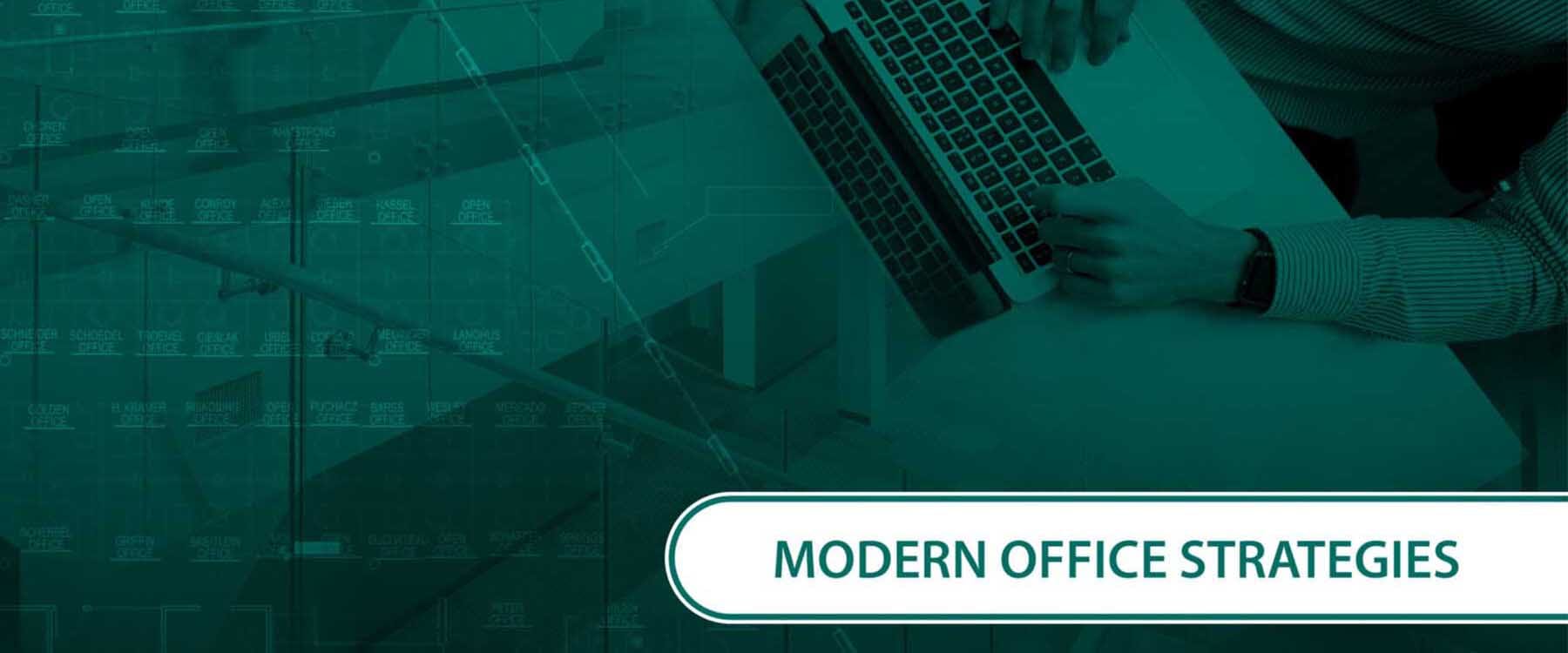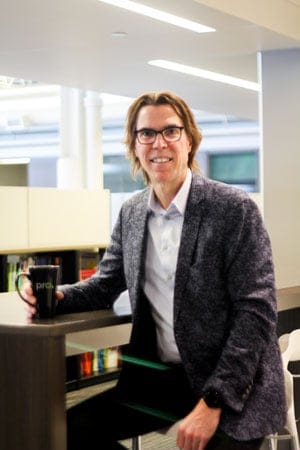Designing the modern workplace involves addressing today’s most common corporate imperatives:
You must have engaged employees.
You must drive innovation.
You must attract and retain the best and the brightest from a diminishing workforce.
You must foster collaboration to tap the full potential of your employees.
As a student of workplace trends and strategies, I sympathize with our clients who have heard all of this before but are unsure of the methods to achieve them. This article aims to clarify the goals while proving that you do not need to choose which of the above to address – they are all closely integrated, and by successfully attacking each of them, you improve your score on all of them. I will also demonstrate that while management strategies are actually more important than architecture in determining your organization’s ability to achieve these goals, architecture and planning play a critical role in the modern workplace.
Background
A recent study entitled “Employee Engagement: The Key to Improving Performance”(1) concluded: “Engagement is about passion and commitment – the willingness to invest oneself and expand ones discretionary effort to help the employer succeed.”
That’s heady stuff – easily recognizable as a worthy goal for any employer. Once achieved, employee engagement itself could drive innovation. But if you look at the five most important things an organization can do to foster engagement,(2) you see that “collaboration” is third on the list:
- Align work efforts with strategy
- Empower employees
- Promote and encourage teamwork and collaboration
- Help people grow and develop
- Provide support and recognition when appropriate
Thus by designing to support the corporate imperative of “collaboration”, we also enhance “employee engagement”. In fact, all four of the imperatives are inter-related and co-dependant. Having the best and the brightest employees to work with is critical, but placing them in collaborative environments can contribute to employee engagement and innovation.
But we all know it’s not that simple.
A 2014 study of the global workforce demonstrated that base pay, job security, and career advancement opportunities are the top three influences of employee job satisfaction.(3) I believe that once these basic needs are met, employers looking for competitive advantages would do well to consider ways to foster each of the corporate imperatives above.
A Modern Workplace: Bader Rutter Headquarters
To demonstrate how we helped one of our clients use their new office to help them address these imperitives, we will examine the new Bader Rutter Headquarters in Milwaukee, Wisconsin.
Bader Rutter (BR), is a business marketing agency previously located in a suburb west of Milwaukee. Since creativity and innovation are so critical to the success and growth of their business, they recognized the need to make radical changes to their physical environment – where it was located, what it felt like, how it functioned – it all had to change if they were to compete for talent, cultivate engaged employees, increase collaboration and drive innovation.
Their first step was to move out of the building they had occupied for many years in a remote office park and relocate to a modern workplace in downtown Milwaukee. They chose to become the major tenant in a new office building composed of a 100 year old manufacturing building coupled with a new, modern addition. The new office would have 260 employees in approximately 60,000 RSF on two and a half floors.
Their primary goals for the space are familiar:
- Attract and retain the best and the brightest employees
- Increase collaboration and cross-pollination.
- Become the premier business marketing agency in the world.
OK, that last one may not sound exactly familiar, although it is not an unusual goal for a business leader. It implies that there is something amazing about the company that distinguishes it from every competitor – something innovative that their clients would find nowhere else.
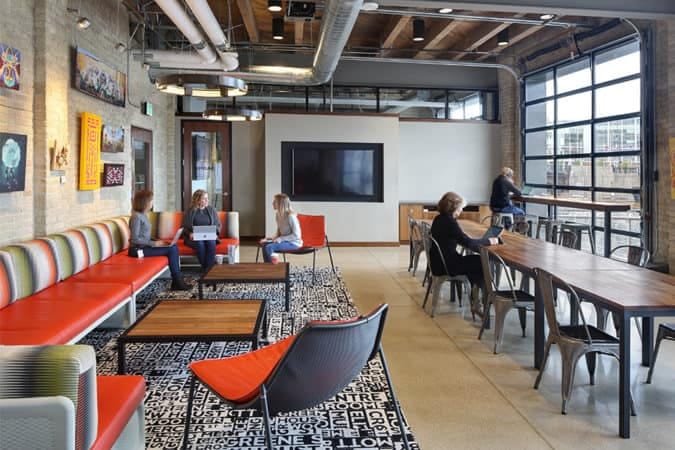
Creating the Anti-Office
Our approach to “Attract and Retain” was inspired by the belief that employers wishing to increase engagement of current employees or attract the best prospective employees should start by offering a curated experience for everyone. Many companies still create “front-of-house” or client experience areas that differ significantly in quality and attention to detail from the “back-of-house” employee areas. Innovative companies strive to treat their current and prospective employees the way they treat their clients. At Bader Rutter, that goal led to the creation of an environment patterned on a boutique hotel, and in doing so, made the staff feel like there was no place they would rather be.
Shortly after opening, one visitor summed up what the Bader Rutter staff had been hearing a lot: “I didn’t know if this was a hotel or an office!”
Key elements that contribute to the accomplishment of this goal:
- The creation of a standing height “Concierge Desk” in lieu of a Reception Desk. (First impressions count.)
- Locating a large, two-story coffee bar in the center of the plan, complete with a central communal table, lounge and bar height furniture, and a river side fireplace.
- Work stations arranged in 120 degree pods in lieu of grids with lounge seating dispersed throughout.
- Lighting fixtures and levels more typically found in hospitality environments, including dimmable suspended discs, floor lamps and decorative pendants.
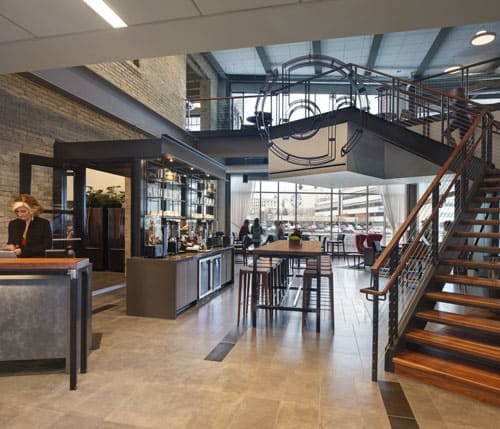
Collaboration that WORKS
There is not a business leader alive today who has not heard that collaboration is the key to success for their business. We’re told that knowledge workers require it, Millenials demand it, and everyone is doing it. But collaboration literally isn’t for everyone, and if poorly implemented, it can in fact be counter-productive. In their book, “The Knowledge Creating Company”,(4) Ikujiro Nonaka and Hirotaka Takeuchi described the four modes of the knowledge-based worker:
- Focusing
- Collaborating
- Learning
- Socializing
A successful business needs to recognize these four modes and provide the correct quantity and location of spaces suited for each of them, sometimes depending on the type of work in a particular department, (ie. Accounting vs. Creative), and sometimes based on the requirements of different individuals. (ie. Introverts and Extroverts.) A modern workplace must provide spaces to support every individual.
At Bader Rutter, we addressed this issue with the following design solutions:
- A 90% reduction in the number of enclosed offices.
- The creation of “Neighborhoods” of no more than 15 open workstations with 42” partitions.
- The creation of small group collaboration spaces, screens and other barriers between the Neighborhoods to mitigate distractions.
- In addition to a large, divisible Training Room, 4 War Rooms, and 5 client facing conference rooms, 1 dedicated conference room per department, one 1-2 person Focus Room per every 5000 sf. was provided ensuring space for focus time if and when anyone needs it.
- Creation of a central Work Café with a monumental stair and an indoor/outdoor space called the “Backyard” to encourage chance interactions, socializing, and collaboration, and even individual focused work in a more social setting.

Walls that Speak
Bader Rutter is a communication company. Their business primarily involves the use of words, images, and sounds to communicate something important about their clients’ goods or services. To stay fresh and relevant, they are creating and innovating daily. That is why their new space needed to be a canvas for their art – a three dimensional and changeable expression of what they do and who they are. The decision to use the boutique hotel as our “muse” for the space infused a strong message into the space, but there were many other branding elements including:
- Each department entrance includes a custom designed, six foot tall video kiosk on which to display anything that department or the agency deems appropriate. The initial concept was for the kiosks to feature a customizable Instagram feed as a way to celebrate the people and the team it represents, but the beauty of video allows for infinite changes to the concept.
- Walls were carefully planned and vistas choreographed to provide areas for long and short term branding and art installations to be seen from both inside and outside the building.
- Fully cognizant of the views from the street outside into the space, the studio created for monitoring social media was designed and oriented so that it can be seen by the cars and pedestrians outside.
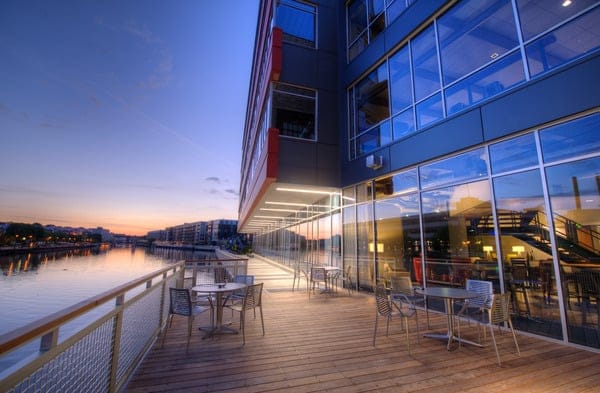
Conclusion
The new Bader Rutter headquarters demonstrates how designing for all of the corporate imperatives – employee engagement, attraction and retention, collaboration and innovation can benefit each of them. Of course, design solutions are not universal, and what works for one client may not work for another. What is universal is that space can help with all of these things, and motivated clients who embrace the corporate imperatives and design for each of them can transform their business.
References:
(1) Solomon Markos, et. al., Dec 2010, “Employee Engagement: The Key to Improving Performance”, International Journal of Business and Management, Vol 5, No 12, 89-96
(2) Richard S Wellins, Paul Bernthal, and Mark Phelps, 2005, “Employee Engagement: The Key to Realizing Competitive Advantage”, Development Dimensions International
(3) Towers Watson, Aug 2014, “2014 Global Workforce Study”
(4) Ikuziro Nonaka and Hirotaka Takeuchi, 1995, “The Knowledge-Creating Company: How Japanese Companies Create the Dynamics of Innovaton.” Oxford University Press
PRA Partner Michael Brush leads PRA’s Corporate Design Studio and provides design leadership across all studios.
